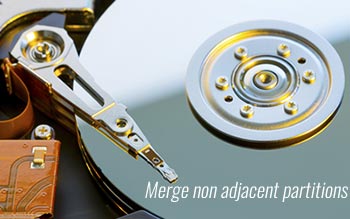All disk partitions are created when installing operating system or by computer seller, but sometimes you need to merge two partitions. For example when C drive is running out of space, you can merge C and D drive to transfer free space. In some computers, there's not enough free space in adjacent D drive, some people want to know if it's possible to merge C drive with a nonadjacent partition. The answer is yes, but only third party software can help you, because Windows native tools cannot merge non adjacent partitions.

Can't merge non adjacent partitions with Windows native tools
There's no "Merge Volume" function in all Windows versions. If you want to merge D to C drive, you can achieve with "Extend Volume" function in Disk Management, but you must delete D drive in advance. In addition, D drive must be a primary partition. Otherwise, Extend Volume option is grayed out. Windows Disk Management (and another diskpart tool) can only merge partition to the left contiguous partition.
If you want to merge non adjacent partitions in Windows 11/10 or a server, no native tool can help you. Because the middle partition must be moved to the left or right, neither diskpart command nor Disk Management has this ability.
How to merge non adjacent partitions in Windows 10/11
It is easy to merge 2 contiguous or non adjacent partitions in Windows PC or server. But you'd better back up in advance and run safe partition software, because there's potential system damage and data loss risk with unreliable software.
When merging non contiguous partitions, the start and end position of these partitions will be changed. All files in the middle partition should be moved to new locations, too. Any slight error will lead to partition corruption. Better than other tools, NIUBI Partition Editor has unique 1 Second Rollback, Virtual Mode and Cancel-at-will and Hot Clone technologies to protect system and data. Furthermore, it is much faster because of the advanced file-moving algorithm.
To merge non adjacent partitions in Windows 11/10/8/7/Vista/XP computer, NIUBI Partition Editor has free edition for home computer users. To do this, you just need to click, drag and drop on the disk map.
How to merge non adjacent partitions in Windows 10/11 with NIUBI:
- Download the free edition, right click E: and select Delete Volume (remember to transfer files in advance), then its disk space will be changed to unallocated.
- Right click D: and select Resize/Move Volume, drag the middle of D drive towards right in the pop-up window, then unallocated space will be moved to the left.
- Right click C: and select Resize/Move Volume again, drag right border towards right in the pop-up window, then unallocated space will be merged into C drive.
- Click Apply on top left to take effect. If you changed your mind, simply click Undo to cancel the pending operations.
Watch the video how to combine non adjacent partitions:
To merge non adjacent partitions in Windows Server 2022/2019/2016/2012/2008, the steps are the same, but you need the server edition.
Resize partitions instead of merging them together
It is easy to merge non adjacent partitions with NIUBI Partition Editor, however, you'll lose a partition. If it isn't an issue, of course you can do like this. But if you don't want to transfer files or delete any partition, you'd better resize partitions instead of merging.
For example: if you want to extend C drive, you may either shrink the adjacent drive D or the non-adjacent partition E to get unallocated space, and then add unallocated space to C drive. In this way, everything keeps the same with before except partition size. Watch the video how to do this:
Besides merging contiguous and non adjacent partitions, shrinking and extending partitions, NIUBI Partition Editor helps do many other disk partition management operations.

